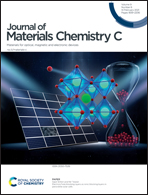Decoding the relationship between the electrocaloric strength and phase structure in perovskite ferroelectrics towards high performance†
Abstract
Electrocaloric effect represents an environmentally friendly cooling alternative to replace the currently ubiquitous vapor-compression-based refrigeration. Previous studies have shown that large electrocaloric response is associated with the polarization change, which peaks around the phase transition temperature. However, there is only little focus on the effect of the detailed phase structure on the electrocaloric properties, particularly on the electrocaloric strength (ΔT/ΔE). For the first time, the correlation between ΔT/ΔE and the phase structure of perovskite ferroelectric materials was investigated, and a new frame to obtain optimized ΔT/ΔE related to the phase structure regulation was revealed. Given the simple and legible phase structure, BaTiO3-based ceramics are selected as a platform to reveal this relationship by employing both indirect and direct measurements. A striking variation of ΔT/ΔE and entropy change coefficient versus the electric field was first noticed at different phase structures: decreasing at the phase boundaries, whereas increasing in the pure phase regions, which could attribute to distinct entropy change mechanisms stemming from the discrepant energy profile at different phase structures. Beyond that, the maximum electrocaloric temperature change of ∼1 K and a large ΔT/ΔE of 0.48–0.25 × 10−6 K m V−1 were achieved under 5–40 kV cm−1. Also, a broad temperature span of 58 K with high ΔT/ΔE was maintained under 40 kV cm−1, and a desired electric field-stable ΔT/ΔE could be acquired. Our research provides a new paradigm for further designing and optimizing the electrocaloric performance of lead-free perovskite ferroelectrics.



 Please wait while we load your content...
Please wait while we load your content...